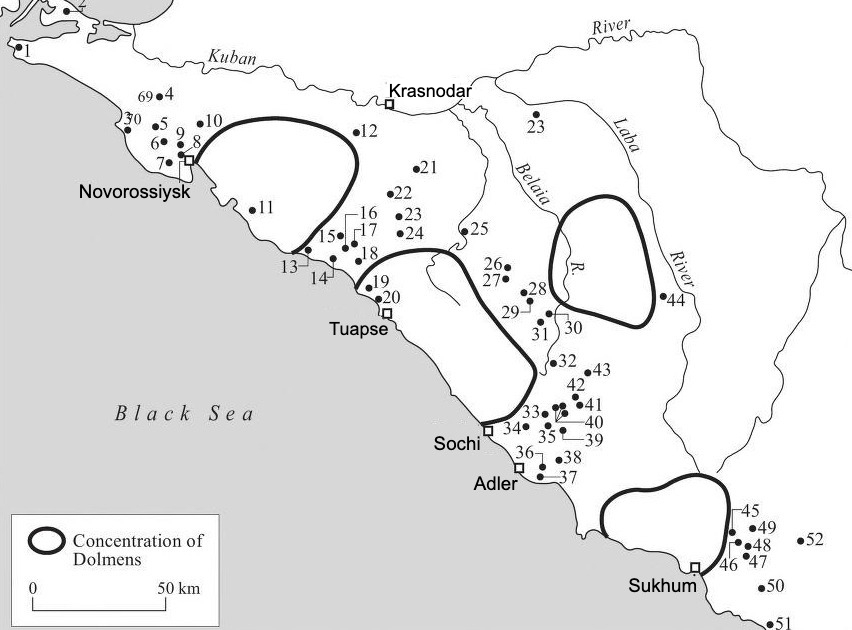What Distiguishes Caucasian Megaliths from European Ones? By Viktor Trifonov

Coloured area – Dolmens of the Western Caucasus.
Trifonov, V. (2013). What distinguishes Caucasian megaliths from European ones? In S. Bergerbrant & S. Sabatini (Eds.), Counterpoint: Essays in Archaeology and Heritage Studies in Honour of Professor Kristian Kristiansen (pp. 321–328). BAR International Series, 2508.
Abstract:
The Caucasian dolmens represent a unique type of prehistoric architecture, constructed using precisely dressed stone blocks. These monuments date from the end of the fourth millennium to the end of the second millennium BC. Their origins remain unknown. Since the early nineteenth century, numerous hypotheses have been proposed to explain the origins of these dolmens through external migrations. Today, this search for parallels continues to be a popular endeavour, albeit sometimes at the expense of more in-depth studies focusing on the dolmens' local cultural, chronological, social, and ecological contexts.
The increasingly rigorous standards of recent excavations in the Caucasus, which encompass the entire structure of the tomb rather than focusing solely on the interiors of burial chambers, are revealing that comparisons between the plans of poorly excavated megalithic sites, whether European or Caucasian, can be dangerously misleading.
Keywords: Megalith, dolmen, reconstruction archaeology, Caucasus, Zhane Valley, Dzhubga, ashlar masonry

Dating to the Bronze Age (3250–1250 BC), the purpose of dolmens remains debated by archaeologists.
Thousands of prehistoric megalithic monuments are known and have been studied worldwide. However, some of the least known and least investigated by archaeologists are those in southern Russia. Commonly referred to as dolmens, these structures are located in the western Caucasus, on both slopes of the Great Caucasus range, and along the north-eastern coast of the Black Sea, extending from Anapa to Ochamchira. This distribution covers an area of approximately 12,000 square kilometres across Russia and Abkhazia.
The Caucasian dolmens represent a distinct type of prehistoric architecture, constructed using specially dressed, precision-cut stone blocks. These monuments date from the end of the fourth millennium to the end of the second millennium BC (Trifonov, 2001). Currently, the archaeological catalogue lists over 3,000 dolmens, typically found in clusters ranging from two or three to several dozen. The largest cluster, located at Kizinka, comprises over 500 dolmens (Markovin, 1978; Markovin, 1997).
While generally unknown outside the region, these Russian megaliths are comparable to the great megaliths of Europe and Asia in both chronology and architectural characteristics. However, their origins remain enigmatic.
Viktor Trifonov
Institute for History of Material Culture, Russian Academy of Sciences, Russia, Saint-Petersburg · Dept. of Central Asia and the Caucasus PhD in Archaeology.
The full article in PDF can be downloaded by clicking here (2.8 MB)
See also:
+ Dolmens and Cromlechs in the Western Caucasus: An Overview
+ Western Caucasian Dolmens by V.I. Markovin

The distribution of dolmens is also noteworthy. The broader Western Caucasus boasts a dense concentration of dolmens, making it one of the most significant areas for studying megalithic structures. Over 3,000 dolmens once dotted the verdant slopes of this region, of which archaeologists have excavated only about 160 to date. While Abkhazia contains many isolated examples, the broader region features large clusters, with some areas hosting hundreds of dolmens. Some dolmens in the Western Caucasus, particularly those near the Black Sea coast, are adorned with unique decorative elements. Carved anthropomorphic stick figures and animal images have been found on the walls of dolmens, such as those at the Dzhubga site. These carvings, though simple, provide rare insights into the artistic expressions and possibly the belief systems of the dolmen builders.
It is significant to note that dolmens are not found in other regions of the Caucasus, such as Chechnya, Dagestan, Ossetia, or Georgia (including Mingrelia and Svanetia). While isolated megaliths exist in these areas, they bear no typological or external resemblance to the dolmens of the Western Caucasus. This distinct distribution sharply separates the Western Caucasus from the rest of the Caucasus in terms of megalithic culture.